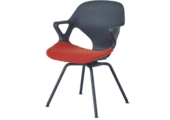Transform! Designing the Future of Energy,
Germany
23 March 2024
More information
Running Remote: Empowering The World's Transition Towards Distributed Work,
Lisbon
22 April 2024
More information
Ergonomics & Human Factors 2024,
Kenilworth, UK
22 April 2024
More information
The Watercooler,
Excel London
23 April 2024
More information
The Office Event,
London
23 April 2024
More information
SME XPO,
Excel London
23 April 2024
More information
Sustainable Design Forum,
London
25 April 2024
More information
The Workplace Event,
Birmingham
30 April 2024
More information
Featured
-

Large increase in the number of people who say they are experiencing burnout
-

The role of emotional intelligence in effective sales leadership
-

Report sets out nine ways cities can reduce carbon emissions
-

Trust gap on AI in the workplace must be overcome if businesses are to get ahead
-

Managers are essential for shaping company culture and a sense of belonging
-

Zeph side chair from Herman Miller adds colour and comfort to your workspace
-

AI is not coming for your job. But it will make it better
© Workplace Insight 2024
Powered by WordPress • Themify WordPress Themes













March 8, 2016
Classrooms are starting to mimic the form and function of the office 0
by Tricia McCall • Comment, Technology, Workplace design
Technology is not the only factor impacting the way education is being approached in the classrooms of today. While it’s true that many classrooms have begun to adapt to the inclusion of technology in the curriculum, there are also several “offline” options which have clearly trickled down from business design. Globally known companies such as Google and Apple have long been getting attention for the offbeat office culture they are cultivating. This trend has been fanning out into the other companies and industries as well. In-house chefs, rock climbing walls, and unconventional meeting spaces are a few of the unusual features popping up in offices all over the globe. Employers are striving to entice potential job candidates and retain their existing employees through unique and engaging environments. It may well be that the bells have already tolled for the conventional cubicle culture of the past.
Sorry students, this doesn’t mean your classrooms will be getting the Ferris wheels and arcade games seen in some of the more notable millennial offices. But changes in the look and design of classrooms are taking similar, although perhaps less lavish, paths.
In a recent publication the Princeton Classroom Design Literature Review repeatedly refers to the need for “active learning environments” that are rich with “vertical collaboration and presentation surfaces (blackboards, whiteboards, etc.)”, this according to Lawson Reed Wulsin Jr. The old paradigm of teacher and blackboard up front, and all the students silently seated facing them is being replaced.
Another signature of today’s classroom is flexibility. Educational publications are noting the trend of educators breaking students into groups and dividing the classroom itself into a collective of independently operating groups. Smaller groups lead to increased participation from the individuals therein. By engaging with the material, educators are hoping students will absorb and put to use that which they have been taught.
Just as their workforce counterparts are happier, healthier contributors when they are able to interact with their environment, so too are students better able to learn and happier to do so when they have the freedom to interact with and move around in their environment. This entire topic begs the question, is education following the lead of the corporate world or is the corporate world trying to infuse the wonder and exploration associated with childhood and early learning?
Although there are those who would argue against these types of changes, seeing it as the corporatization of education, one can clearly counter that these changes actually represent the relaxation of the rigid “rules” of the past. A healthy sense of play enriches the minds and improves the productivity of student and employees alike.
____________________________________
Tricia McCall works for WriteyBoard (www.writeyboards.com). Images: Top, Google offices, Zurich; above, Educators for Excellence, New York by Kati Curtis Design.